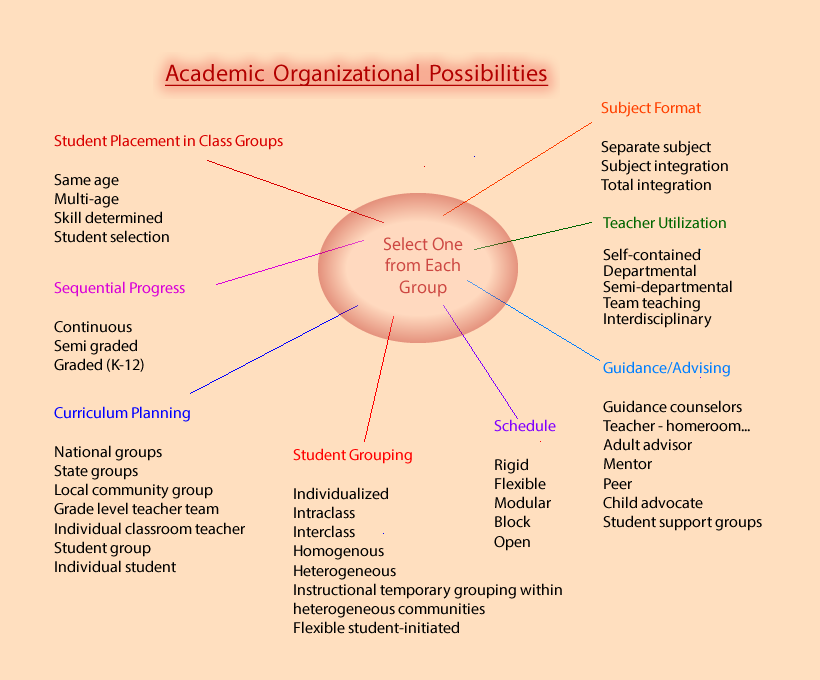School & classroom organizational structure (grammar)
Introduction
This page identifies variables used to organize schools and classrooms, for your study and considerations on how they affect schooling.
They are presented within a historical perspective to consider how any organizational change may better meet the needs of learners, teachers, communities, and economics to achieve the desired outcomes of education efficiently.
To support the difficulty of how hard it is to change our historical grammar, review New Jersey's struggle to expand K-12 to preK-12 in Expanding access to preK and the legacy of Abbott v. Burke. in Kappan September 27, 2021.
Schooling grammar
Grammar of schooling is the organizational and pedagogical forms of schooling that have persisted over the years and resisted efforts to reform them, shaping the structure of teaching and learning in much the same way as grammar shapes language. (Tyack & Cuban)
Categories can include:
| Category | Historical grammar | Propose grammar |
|---|---|---|
| Purpose | Prepare for the social order | Prepare with agency and purpose to maintain and remake the social order |
| Pedagogical goal | Assimilate preexisting knowledge | Engage in using and creating knowledge as producers in a variety of field and worth human pursuits |
| Ethos | Transactional | Relational |
| View of knowledge | Pre-specified and discipline centered | Constructed, interconnected, and dynamic |
| Boundaries between disciplines | Strong | Permeable |
| Learning modality | Teaching as transmission | Learning by doing; apprenticeship learning |
| Learner choice | Limited | Open, multiple |
| Time | Short fixed blocks | Variable blocks with sufficient time for immersive experiences |
| Space | Individual classrooms | Variable linked spaces |
| Assessment | Time on task, standardized tests | Creation of worthy products (projects, portfolios, performance, research |
| Groupings | Age-graded, ability, class, race | Cross-age learning, integration of students across ability, class, race |
| Equity | Closing gaps on assessment | Recognizing, knowing, and loving students and holistically helping them reach their potential. |
| Places where students learn | Schools | Various spaces (home, school, community, centers, Online, field experiences |
| Organizational model | Linear, top-down planning | Distributed leadership and emergent change |
School organization categories
A meta analysis of school organizations found the organization of classroom in schools can be described by several variables, some of which are more dominant than others and all have historic roots, which today may be advantageous or not, but some are more deeply rooted in today’s schools. These can include the following:
- Student placement in class groups
- Sequential progress
- Curriculum planning
- Student grouping
- Schedule
- Guidance / advising
- Teacher utilization
- Subject format
Displayed in this diagram:

Typical historical grammar
Let’s review these elements for a stereotypical grammar of schooling today:
- Student placement in class - same age to achieve learners with similar abilities
- Sequential progress - graded K-12, social promotion, credits, diploma
- Curriculum - state and district mandate based on traditional subjects
- Student grouping - learners grouped by age and placed in graded classrooms
- Schedule - rigid start and stop time for school and different subjects
- Subject format - separate subjects; elementary 3’rs secondary college prep courses
- Teacher utilization - teacher centered instruction; self contained classroom
- Guidance & advising - teacher with counselor support
Historical analysis
Historically schooling started with tutors and master craftsmen teaching a special task or skill to select apprentices or a select few for college prep in very small groups or often one on one. As schooling becomes more necessary, parents organize to hire tutors for larger groups of learners. Eventually groups become larger as schools have multiple classrooms and teachers. Class sizes and instructional methods are determined mostly based on economy and efficiency. This resulted in increased class sizes as well as multiple sections. Skills becoming subjects. Decisions on how to group students. Abilities being related to age. Progress associated with grade levels. Failure resulting in repeating grades and success leading to a diploma. Eventually failure caused large numbers of students being left behind so social promotion is initiated.
While social promotion means much older and younger learners are not grouped together, it increases the differences between abilities of learners in heterogeneous age groups. Therefore, ability grouping and putting learners into different tracks (college prep track, academic track, feral track, vocational track, remedial track …) is initiated to assist teachers by having more homogeneous groups to teach.
All of these different tweaks on organization were to achieve the purposes of education with schooling. Most, a missions that is merit based and egalitarian, to achieve an ideological vision by using principled procedures to guide decision making, set goals, and achieve outcomes that satisfy the community who provide the resources to achieve their (communities, parents, and learners) vision of education through schooling. All which is too often based on personal emotionally charged grammars, than based on research and wisdom of practice. Which appears to be an acceptable organization that is:
- Legitimate
- Worthy
- Doable
- Practical
- Easy
- Recognizable
- Accountable
- Successful
- Repeatable
Learning environment management - structure, proactive, supporting tools, instruction, risk free environment, grouping, materials & space, transitions, & parent & community involvement
Pedagogy - Curriculum, teaching, learning, human development & planning